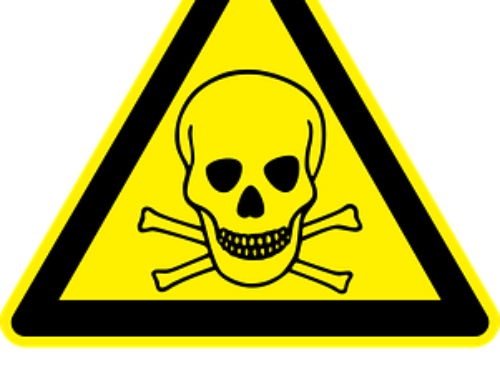Shale oil toxicity (Chapter in Encyclopedia of Toxicology, Third Edition, 2014)
Abstract: Shale oil (CAS 68308-34-9) is a mixed-base crude oil extracted from sedimentary shale formations. The oil-bearing component of the shale is called kerogen, which is a bitumen-like solid material consisting of a mixture of aliphatic and aromatic hydrocarbons. Shale oil is a primary irritant, a reproductive effector, a multi-organ toxicant, a mutagen, and a tumorigen. It has been found to be carcinogenic in animals and humans.
Synonyms: blue oil, green oil, unfinished lubricating oil, EINECS 269-646-0
Chemical formula: unspecified (mixture of hydrocarbons)
Chemical structure: unspecified (mixture of hydrocarbons)
Background:
Shale oil (CAS 68308-34-9) is a type of crude oil extracted from sedimentary shale formations by heating the shale to 425 to 535 degrees Celsius (800 to 1,000 degrees Fahrenheit). The specific gravity of shale oil ranges from 0.9 to 1.0, which exceeds that of natural crude oil. Two methods are used to extract the oil from the shale. The shale can be excavated, crushed, and fed into retorts for heating (retorting) and extraction. Alternatively, shafts can be driven into the shale formation and the shale is heated in situ. Only about 75 to 110 liters (20 to 30 gallons) of oil can be extracted from a metric ton of shale. The oil extracted from oil shale is somewhat similar to oil pumped from conventional oil wells, but shale oil extraction is more complex and expensive than convention oil extraction processes.
Shale oil has been extracted from the earth and employed for various uses since ancient times. As early as 1637, shales in Sweden were roasted over wood fires to extract potassium aluminum sulfate, a salt used in tanning leather and for fixing colors in fabrics. Late in the 1800s, oil shales were retorted on a small scale for hydrocarbon recovery. Production continued until 1966 when it was discontinued because of the availability of cheaper supplies of petroleum crude oil.
Oil shale deposits in France and Scotland were exploited commercially as early as the mid 1800s. As many as 20 beds of oil shale were mined in Scotland at different times. Mining continued during the 1800s and by 1881 oil shale production had reached one million metric tons per year. Between 1 and 4 million metric tons of oil shale were mined yearly in Scotland from 1881 to 1955 when production began to decline, then ceased in 1962. Canada produced some shale oil from deposits in New Brunswick and Ontario starting in the mid-1800s. Common products made from oil shale in these early operations were kerosene and lamp oil, paraffin, fuel oil, lubricating oil and grease, and ammonium sulfate.
The oil-bearing component of the shale is called kerogen. Kerogen (CAS 8032-30-2) is a bitumen-like solid material consisting of approximately 75 percent carbon, 10 percent hydrogen, 2.5 percent nitrogen, 1.0 percent sulfur, and the balance oxygen. Kerogen is a mixture of aliphatic and aromatic hydrocarbons of humic and algal origin. It was formed millions of years ago by deposition of silt and organic debris on lake beds and sea bottoms.
Shale oil differs from crude oil from other sources in that it contains significant amounts of nitrogen (about 35 percent), oxygen (about 20 percent) and sulfur (about 5 percent) compounds. Nitrogen compounds include pyridine, quinoline, amines, pyrrole, and indole. The major oxygen-containing compounds are phenols, carboxylic acids, and ketones. Sulfur compounds found in shale oil include sulfides, thiols, and thiophenes.
The remainder of shale oil consists of hydrocarbons. An analysis of shale oil from the western United States found 12 percent isoalkenes and cycloalkenes, 6 percent polycyclic aromatic hydrocarbons, 6 percent normal olefins, 6 percent normal alkanes, 4 percent monocyclic aromatic compounds. After fractionating and refining the oil yields about 20 percent gasoline, 30 percent kerosene, 30 percent gas oil, and 20 percent lube oils.
Oil shale is found worldwide, but the largest deposits are in the Green River Formation that covers portions of Colorado, Utah, and Wyoming in the United States. Oil reserves in this formation have been estimated to range from 1.2 to 1.8 trillion barrels. Not all of these reserves are recoverable, but about 800 billion barrels could be extracted from this formation using currently available technologies. At the present rate of oil consumption in the United States, this represents about a 400 year supply.
Uses:
Shale oil, as mentioned above, is used in the production of gasoline, kerosene, gas oil, and lube oils. Other products that can be made from shale oil include varnishes, pitches, and mastics. The latter products are employed as solvents and glues, and as starting materials for the printing and rubber products industries. Sulfonated shale oils (e.g. Ichthyol) have found uses as pharmaceutical agents for the treatment of skin diseases such as eczema and psoriasis, rheumatic diseases, and even for the treatment of blunt trauma. Human testing has shown that sulfonated shale oils are without significant side effects and are as effective as hydrocortisone in treating inflammatory lesions of the skin.
Environmental Behavior, Fate, Routes, and Pathways:
Releases of shale oil components to the environment can occur in several ways during the extraction, processing, and transport of this material. The more volatile components of shale oil can be released to the atmosphere especially during the retorting process when heat is applied to the shale. Workers at shale processing plants and, to a lesser extent, people residing near those operations can be exposed to the lighter volatile organic chemical components of shale oil released into the air. Spills or other accidental releases of shale oil and its components can threaten wildlife and adversely impact aquatic organisms if the material reaches surface waters. In some areas, spills of oil could reach shallow aquifers thus affecting ground water. Soil contamination is an obvious result of such spills as well.
Exposure and Exposure Monitoring:
Workers involved in oil shale mining and processing may be exposed to complex mixtures of dusts, gases and vapors containing organic compounds, including low levels of polynuclear hydrocarbon compounds. Skin contact with crude shale oil may occur, but is limited primarily to maintenance workers in modern oil shale processing facilities. Contact with shale oil liquids occurred extensively in the past in the Scottish shale oil industry, and in the British cotton-textile industry where lubricants derived from shale oils were used.
Recent studies in areas of Texas in which intensive shale oil and gas exploration and extraction occur have not shown increased levels of oil and gas-related volatile organic compounds in the blood of individuals living in these areas.
Toxicokinetics:
The two components of shale oil that pose the highest risk to human health are the lighter components of shale oil, such as phenols, and polycyclic aromatic hydrocarbons that are present in the heavier fractions. The toxicokinetics of these two fractions will be discussed here.
Phenols:
Phenols are rapidly and efficiently absorbed through skin, lungs, and the gastrointestinal tract. 70 to 80 percent of inhaled phenol is absorbed by humans within an 8-hour exposure. Six-hour dermal exposures to phenol also resulted in 70 to 80 percent absorption in humans. Phenol is rapidly distributed to all tissues in exposed animals. After oral administration in rats, the highest concentrations were found in the liver, followed by spleen, kidney, adrenal gland, thyroid and lungs. In rabbits, the highest concentrations of phenol were in the liver, followed by the CNS, lungs and blood. After ingestion of phenol, there is a large first-pass metabolism. The liver, lungs and the gastrointestinal mucosa are the most important sites of phenol metabolism. Absorption into the blood stream also occurs after inhalation of shale oil. Conjugation with glucuronic acid has been shown to be major metabolic pathway in several species. Both in vivo and in vitro tests have shown covalent binding of phenol to tissue and plasma proteins. Some phenol metabolites also bind to proteins. Urinary (renal) excretion is the major route of phenol elimination in animals and humans. The rate of excretion varies with different species, dose and route of administration. A minor amount of phenol is eliminated in the feces and in expired air. The natural presence of phenols in food and drug metabolites makes biological monitoring difficult if not impossible. The biological half-life of conjugated phenol in humans has been reported to be between 4 and 5 hours.
Polycyclic Aromatic Hydrocarbons:
Polycyclic aromatic hydrocarbons (PAHs) are lipophilic compounds and can be absorbed through the lungs, the gastrointestinal tract, and the skin. In studies of the distribution of PAHs in rodents, both the parent compounds and their metabolites were found in almost all tissues and particularly those rich in lipids. In humans, the major routes of uptake of PAHs are thought to be through (i) the lungs and the respiratory tract after inhalation of PAH-containing aerosols or of particulates to which a PAH has become absorbed; (ii) the gastrointestinal tract after ingestion of contaminated food or water; and (iii) the skin as a result of dermal contact with PAH-bearing materials. The whole-body distribution of PAHs has been studied in rodents. The investigations have shown that (i) detectable levels of PAHs occur in almost all internal organs, (ii) organs rich in adipose tissue can serve as storage depots from which the hydrocarbons are gradually released, and (iii) the gastrointestinal tract contains high levels of hydrocarbon and metabolites, even when PAHs are administered by other routes, as a result of mucociliary clearance and swallowing or hepatobiliary excretion. The metabolism of PAHs follows the general scheme of xenobiotic metabolism wherein the hydrocarbons are first oxidized to form phase-I metabolites. The phase-I metabolites are then conjugated with either glutathione, sulfate, or glucuronic acid to form phase-II metabolites, which are much more polar and water-soluble than the parent hydrocarbons. Most metabolites of PAHs are excreted in feces and urine. The urinary excretion of PAH metabolites has been studied more extensively than fecal excretion, but the importance of the enterohepatic circulation of metabolites has led to increased research on the latter. During metabolism, PAH moieties become covalently bound to tissue constituents such as proteins and nucleic acids. The persistence of these adducts is of considerable interest since this is one of the basic features of the mechanism of carcinogenesis.
Mechanisms of Action:
Shale oil is a mixture of many different chemical compounds. A fairly accurate account of the mechanisms of action of shale oil can be given based on the mechanisms of the major toxic components of the oil. These are phenols and other phenolic compounds present in the lighter end components of shale oil and polycyclic aromatic hydrocarbons that are present in the heavier fractions.
Phenols:
Phenols, one of the more volatile components of shale oil, can be toxic at fairly low levels of exposure. Cellular uptake of phenols is due to their lipophilic character. Phenols denature proteins and disrupt disulphide bridges in keratin in the skin. Both in vivo and in vitro tests have shown covalent binding of phenol and phenol metabolites to tissue and plasma proteins. The acute lethality of phenols, associated with exposure to high dose concentrations, is usually attributed to a depressant effect on the CNS.
Polycyclic Aromatic Hydrocarbons:
The prevailing current theory of the mechanism of chemical carcinogenesis, that reactive electrophiles are the ultimate carcinogens, applies to polycyclic aromatic hydrocarbons. According to this theory, PAHs are activated by microsomal enzymes to proximate and finally ultimate carcinogens, which are characterized by a reactive electrophilic center. These chemicals can then react with nucleophilic sites on macromolecules such as DNA, RNA, and proteins. This results in changes in these molecules that increase the risk of carcinogenesis.
Acute and Short Term Toxicity
Shale oil demonstrates a relatively low level of acute toxicity by various routes of exposure in experimental animals. Table 1 summarizes the results of acute toxicity studies that have been reported.
Table 1. Summary of Results of Acute Toxicity Testing for Shale Oil
| Animal Species | Route of Administration | 50% Lethal dose
(LD50 or LC50) |
| Rat | Oral | 8 grams/kg |
| Rat | Inhalation | 3,950 mg/m3 |
| Mouse | Oral | 11 grams/kg |
| Mouse | Interperitoneal | 4.3 grams/kg |
| Rabbit | Skin | 5 grams/kg |
Shale oil is a mixture of hundreds, if not thousands of hydrocarbon chemicals with different volatilities. Studies have been conducted using mice as the experimental animals that compared the toxicity of the lighter end (lower boiling point, higher volatility) components of shale oil and the heavier end components. The LD50 for the lighter ends was 63,000 mg/m3 and the LD50 for the heavier ends was 16,000 mg/m3. Thus the toxicity of the higher molecular weight phenols is greater, but the volatility of these chemicals is much smaller than that of the lighter end phenols.
The relatively high levels of phenolic compounds in shale oil are thought to be responsible for much of the toxicity seen in animal studies. Rats and rabbits getting daily oral doses of less than 40 milligrams per kilogram (which is about 200 times smaller than lethal doses) of phenol for seven months showed weight loss, increased blood pressure, changes in peripheral blood, and changes in liver, kidneys, and spleen.
Chronic Toxicity:
Rats exposed by inhalation to 492 milligrams per cubic meter (mg/m3) of shale oil for six hours per day for 13 weeks showed changes in lung weight, inflammatory responses, development of areas of hyperplasia in the lung and upper respiratory tract, decreased erythrocyte count, thymic atrophy, and decreased weight gain. Rats exposed to 10 mg/m3 shale oil for six hours per day for two years (lifetime study) experienced structural changes in the trachea and bronchi.
Shale oil exposures of 13 or 33 mg/m3 four hours per day, four days per week for four weeks did not cause any adverse effects in hamsters. Hamsters intermittently exposed to 50 mg/m3 shale oil over 69 weeks showed changes in the respiratory tract. Some lethality was also reported at this exposure level. Monkeys intermittently exposed to 10 mg/m3 shale oil for six hours per day over two years showed respiratory tract effects related to this exposure.
Other effects seen in studies of shale oil exposure of animals (independent of route of exposure) include lack of coordination, convulsions, paralysis, and narcosis. Anemia, leucopenia, impaired liver, spleen, and kidney function, reduced content of sulfhydryl groups, and reduced serum glucose levels have also been observed. Liver effects included fatty degeneration and reduced protein synthesis. Changes in kidney function were characterized by increased blood urea nitrogen, albuminuria, ketonuria, and glycosuria. Proliferation of endothelial cells in the kidney glomerulus has also been noted in animal studies.
Workers chronically exposed to oil shale and its components suffered skin irritation and irritation of the mucous membranes of the respiratory tract. Dermal contact caused allergic contact dermatitis, folliculitis, warts, and vitiligo-like dermatoses. Additional symptoms included neurotoxic effects, effects on the peripheral blood system, and increased urinary excretion of phenols, sulfates, and glucuronic acid. Most of the overt symptoms seen in oil shale workers were subjective in nature, such as headaches, fatigue, irritability, and sleep disorders.
Immunotoxicity:
Exposure to shale oil has been found to reduce the immunological resistance of workers. These changes seem to be correlated less with length of exposure to the oil than with individual susceptibilities. The presence in shale oil of polycyclic aromatic hydrocarbons, well-known immunotoxicants, may explain this effect.
Reproductive and developmental toxicity:
Male mice administered 200 milligrams per kilogram of shale oil via interperitoneal injection one day prior to mating experienced changes in spermatogenesis. A reduction in fertility (reduction in number of implants per female) was also seen in this study. Oral administration of shale oil at a level of 0.1 grams per kilogram per day for four months caused changes in the sexual cycle as well as a decrease in the numbers of primordial follicles in the ovaries of the females and a decrease in the quantity of normal spermatogonia in the testicular germinal epithelium in the males.
Genotoxicity:
Chromosomal aberrations were induced in the bone marrow cells of rats given raw shale oil by gavage. In vitro tests of raw oil shale gave negative results in bacteria, yeast and cultured mammalian cells. Spent oil shale yielded contradictory results in bacterial mutation assays and were negative in mutation assays with eukaryotic cells in vitro and in a chromosomal assay in vivo. Shale-derived crude oils were mutagenic in bacteria, yeast and cultured mammalian cells following metabolic or photo-induced activation. Crude shale oil did not induce mitotic gene conversion in yeast but did induce sister chromatid exchanges in cultured mammalian cells. Both positive and negative results were obtained in mammalian in vivo assays for chromosomal effects.
Carcinogenicity:
Shale oil applied to the skin of mice resulted in skin tumors at the site of application at doses of 20 grams/kg for 30 weeks of exposure and above. The carcinogenic activity of various fractions of low- and high-temperature shale-oils tested by skin application in mice and rabbits did not necessarily parallel the benzo[a]pyrene content of the fractions. Less refined shale oils showed higher skin cancer activities than more refined products.
Rats exposed to 182 grams/kg of shale oil via interpleural injection for 87 weeks developed lung tumors. Shale oil dusts induced lung tumors in rats after inhalation exposure. No lung tumors occurred in rats or hamsters exposed by intertracheal administration to a suspension of the spent oil-shale dusts.
65 cases of skin cancer (including 31 of the scrotum) have been reported from the Scottish shale oil industry. A cohort study of shale oil workers in the western United States found statistically significant excesses of total cancer and of colon cancer, although data on duration and time since first exposure were not available. A cohort study of shale oil workers in Estonia found significant excesses of skin cancer, but not of cancers at other sites.
The International Agency on Cancer Research (IARC) has concluded that there is sufficient evidence for the carcinogenicity in experimental animals of processed shale oils, limited evidence for the carcinogenicity in experimental animals of raw and spent shale oils, and sufficient evidence that shale oils are carcinogenic in humans.
Clinical Management:
Clinical management of individuals acutely over-exposed to the vapors or aerosol mists of shale oil is largely supportive in nature. Once the exposure has been terminated and the victim has been removed to an uncontaminated area, adverse symptoms will generally resolve. Dermal contact with shale oil can cause local irritation if the material is allowed to stay on the skin for extended periods of time. Washing the affected area with a mild solvent or soap and warm water, if accomplished quickly enough, should be sufficient to prevent further skin damage and absorption of the oil into the skin.
Ecotoxicology:
Accidental spills of shale oil during extraction and processing could pose a danger to native fish species and aquatic food chain organisms. Concentrations of the water-soluble fractions of shale oil that were lethal to 50 percent of Cutthroat trout (a species indigenous to shale oil producing areas in the United States) ranged from 1.3 to 2.1 milligrams per liter. Exposure to lower levels of shale oil fractions reduced the swimming ability of fish. Aquatic invertebrates were also adversely affected by shale oil exposure, the most sensitive species of which suffered significant lethality at shale oil extract levels of from 0.5 to 0.7 milligrams per liter.
Exposure Standards and Guidelines:
There are no Occupational Safety and Health Administration (OHSA) Permissible Exposure Limits (PEL), National Institute for Occupational Health (NIOSH) Recommended Exposure Limits (REL), or American Conference of Governmental Industrial Hygienists (ACGIH) Threshold Limit Values (TLV) for shale oil. Likewise, shale oil does not have a Minimal Risk Level (MRL) as established by the Agency for Toxic Substances and Disease Registry (ATSDR), an Acute Exposure Guideline Limit (AEGL), a Temporary Emergency Exposure Limit (TEEL), or an Emergency Response Planning Guideline (ERPG). It is not listed in the EPA’s Integrated Risk Information System (IRIS). It does not have a short- or long-term Reference Exposure Limit (REL) or a cancer potency factor (CPF) from the California EPA. Shale oil is not included in the 12th Report on Carcinogens prepared by the National Toxicology Program (NTP).
Further Reading:
European Parliament. Directorate General for Internal Policies. Policy Department A: Economic and Scientific Policy (2011). Impacts of shale gas and shale oil extraction on the environment and on human health.
Kahn, H. (1979). Toxicity of oil shale chemical products. Scandinavian Journal of Work, Environment, and Health 5,1-9.
International Agency for Research on Cancer (1985). Polynuclear aromatic compounds, Part 4, bitumens, coal-tars and derived products, shale-oils and soots: summary of data reported and evaluation. IARC Monographs on the Evaluation of Carcinogenic Risks to Humans 35, 161-163.
Texas Department of State Health Services (2010). Final report: Dish, Texas exposure investigation.
Veldre, I.A. and Janes, H.J. (1979). Toxicological studies of shale oils, some of their components, and commercial products. Environmental Health Perspectives 30, 141-146.
Zielinska, B., Fugita, E. and Campbell, D. (2010). Monitoring of emissions from Barnett Shale natural gas production facilities for population exposure assessment. Desert Research Institute.
Relevant Web Site Links:
Bureau of Land Management: http://www.blm.gov
Oil Shale and Tar Sands Programmatic Environmental Impact Statement: http://ostseis.anl.gov





